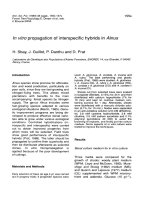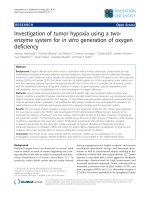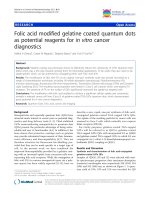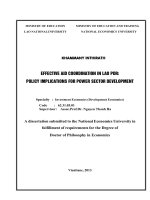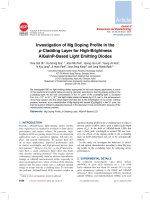investigation of effective media for in vitro propagation of stevia rebaudiana bertoni
Bạn đang xem bản rút gọn của tài liệu. Xem và tải ngay bản đầy đủ của tài liệu tại đây (426.28 KB, 25 trang )
MINISTRY OF EDUCATION & TRAINING
CAN THO UNIVERSITY
BIOTECHNOLOGY RESEARCH & DEVELOPMENT INSTITUTE
SUMMARY
BACHELOR OF SCIENCE THESIS
THE ADVANCED PROGRAM IN BIOTECHNOLOGY
INVESTIGATION OF EFFECTIVE MEDIA
FOR IN VITRO PROPAGATION OF STEVIA
REBAUDIANA BERTONI
SUPERVISOR
STUDENT
MSc. TRAN THI XUAN MAI
NGUYEN THANH HUY
Student code: 3082597
Session: 34 (2008-2013)
Can Tho, 2013
APPROVAL
SUPERVISOR
TRAN THI XUAN MAI
STUDENT
NGUYEN THANH HUY
Can Tho, May …, 2013
PRESIDENT OF EXAMINATION COMMITTEE
NGUYEN HUU HIEP
ABSTRACT
Stevia (Stevia rebaudiana Bertoni), a natural noncaloric sweetener, can be used as sugar replacement
for
patients
suffering
from
diabetes,
obesity,
hypertension or on-diet people. In this research, in
vitro propagation of stevia, was carried out in 4
experiments
(callusing,
shooting,
rooting,
and
acclimatization). The results supported that MS medium
(including vitamins) supplemented with 0.2mg/l NAA
and 0.15mg/l BAP was the best formula for not only
callusing with 92.6% of explants forming profuse calli
but also shooting, 100% of nodal segment developed
healthy shoots (1.15cm in average length) with hairy
and obovate leaves after 21 days. In rooting stage, MS
medium (basal salt mixtures) supplemented with
0.5mg/l IAA had resulted in 83.33% responses with
fibrous roots (9.7 roots/explant and 2.2cm/root).
Maximum
percentage
(100%)
of
plantlets
was
successfully acclimatized in the mixture of 1 soil: 1
sand: 1 decomposed rice straw (v/v) after 3 weeks.
(Keywords: BAP, IAA, in vitro, NAA, stevia)
i
CONTENTS
Page
Approval........................................................................................
Abstract ........................................................................................i
Contents ..................................................................................... ii
Chapter 1: Introduction............................................................. 1
Chapter 2: Materials and Methods ........................................... 2
2.1. Materials ................................................................. 2
2.2. Methods ................................................................... 2
2.2.1. Experiment 1: Study on the effects of
different media on callusing of stevia leaves. .... 2
2.2.2. Experiment 2: Study on the effects of
different media on the multiplication of shoot
from nodal segments. ......................................... 3
2.2.3. Experiment 3: Study on the effects of
different media on root induction ....................... 3
2.2.4. Experiment 4: Acclimatization................. 4
2.2.5. Statistical method ..................................... 4
Chapter 3: Results and Discussion ........................................... 5
3.1. Experiment 1: Study on the effects of different
media on callusing of stevia leaves. .............................. 5
3.2. Experiment 2: Study on the effects of different
media on the multiplication of shoot from nodal
segments. ........................................................................ 8
3.3. Experiment 3: Study on the effects of different
media on root induction .............................................. 12
3.4. Experiment 4: Acclimatization ........................... 15
ii
Chapter 4: Conclusions and Suggestions ............................... 17
4.1. Conclusions ........................................................... 17
4.2. Suggestions ............................................................ 17
References ................................................................................. 18
iii
CHAPTER 1
INTRODUCTION
Stevia (Stevia rebaudiana Bertoni), also known as sugar
leaf, honey leaf, or sweet weed, is perennial shrub belonging to
genus Stevia, family Asteraceae. Stevia is said to be a natural
sweetener due to stevioside compounds found mostly in leaf
content. Steviosides can be used as sugar replacement for patients
suffering from diabetes, obesity, hypertension, or on-diet people
since they are 300 times sweeter than sugarcane, delicious, and
non-caloric.
The demand on stevia is increasing in recent years
accompanying with the significant rising rate of mentioned
diseases. Consequently, large-scale production of this valuable
herb is expanded in many provinces of Vietnam requiring much
investment for not only growing techniques but also large number
of homogeneous and disease-free plantlets. Propagation by seeds,
however, is very poor and usually results in great variability in
features like sweetening levels and composition. Moreover,
vegetative propagation can be done from stem nodes but
limitation in number is a facing problem (Guruchandran and
Sasikumar, 2013). Plant tissue culture is thus an alternative way
for rapid and mass production of stevia.
Objective
This research, “Investigation of effective media for in
vitro propagation of Stevia rebaudiana Bertoni”, was aimed to
find out a complete process for plant tissue culture of stevia,
starting from callusing, shoot multiplication to rooting and finally
acclimatization.
1
CHAPTER 2
MATERIALS AND METHODS
2.1. Materials
In vitro grown stevia from Ha Noi
Chemicals and equipments in Plant Genetics
Engineering laboratory, Biotechnology Research and
Development Institute, Can Tho University.
2.2. Methods
All media were prepared with 20g/l sucrose and solidified
with 8g/l agar. The pH was adjusted to 5.8 before autoclaving at
121oC and 1atm pressure for 20 minutes. All the cultures were
placed under stable conditions, at temperature 27±1oC, light
intensity 1000lux, 16-hour illumination per day.
2.2.1. Experiment 1: Study on the effects of different
media on callusing of stevia leaves.
This experiment was set up to test the appropriate medium
and
supplemented
phytohormones
for
leaf-derived
callus
formation.
Placing 0.3-0.5cm2 leaf explant on different media. It was
noted that the dorsal side should be in contact with the medium
surface.
There were totally 6 treatments with 3 repetitions.
S1: MS (Basal salt mixtures)+1mg/l Kinetin+2mg/l 2,4-D
S2: MS (Basal salt mixtures)+0.75mg/l NAA+1mg/l 2,4-D
S3: MS (Basal salt mixtures)+3mg/l 2,4-D
S4: MS (Basal salt mixtures)+0.5mg/l BAP
S5: MS (Including vitamins)+0.15mg/l BAP+0.2mg/l NAA
S6: MS (Including vitamins)+0.2mg/l BAP+0.5mg/l IAA
2
There were 9 leaf explants cultured on each Petri dish and 3
Petri dishes for a repetition.
For each treatment, the ratio of explants forming callus was
recorded.
2.2.2. Experiment 2: Study on the effects of different
media on the multiplication of shoot from nodal
segments.
This experiment was carried out to obtain the most effective
medium for shoot multiplication from stem nodes.
1-cm nodal segments were cultured on different media.
There were totally 3 treatments with 3 repetitions.
C1: MS (Basal salt mixtures)+0.2mg/l NAA+0.15mg/l BAP
C2: MS (Including vitamins)+0.2mg/l NAA+0.15mg/l BAP
C3: MS (Basal salt mixtures)+3.5mg/l BAP
There were 4 explants cultured on each Petri dish and 3
Petri dishes for a repetition.
For each treatment, the ratio of shooting explants, the
number of shoots per explant, and average shoot length were
recorded.
2.2.3. Experiment 3: Study on the effects of different
media on root induction.
This experiment aimed to find out the best medium for root
induction.
4-cm-and-above shoots were subcultured in various media
for rooting
There were totally 3 treatments with 3 repetitions.
R1: MS (Basal salt mixtures)+ 0.5mg/l IAA.
3
R2: 1/2MS (Basal salt mixtures)+100mg/l activated
charcoal.
R3: MS (including vitamins)+0.5mg/l IAA.
There were 4 explants cultured on each Petri dish and 3
Petri dishes for a repetition.
For each treatment, the ratio of plantlets emerging roots, the
number of roots per plantlet, and average root length were
recorded.
2.2.4. Experiment 4: Acclimatization
This experiment was to harden the rooted plants from in
vitro environment to nursery.
After 50 days cultured on the rooting medium, rooted
plants were taken out of the bottles and removed agar under tap
water. The plantlets were then transplanted to plastic glasses
containing mixture of soil, sand and decomposed rice straw (1:1:1
v/v/v). During the first week, plantlets were covered by plastic
bags and kept under well-managed conditions (temperature
27±1oC, light intensity 1000lux, 16-hour illumination per day). In
the second week, plastic bags were bored to allow air flow
passing inside. From the third week, non-covered plantlets were
transferred to the greenhouse.
The survival rate was recorded after 3 weeks.
2.2.5. Statistical method
Data were stored in Microsoft Office Excel 2003 and analyzed by
Statgraphics Centurion XV.
4
CHAPTER 3
RESULTS AND DISCUSSION
3.1. Experiment 1: Study on the effects of different media
on callusing of stevia leaves.
Among 6 treatments, only 3 of them formed callus after 3
weeks cultured. In table 4, it could be clearly seen that S5 was the
most effective formula with 92.6% of explants developing
profuse yellow calli, statistically different from the others at 95%
confidence level. Under stereoscopic magnifier (10x1.6x1),
differentiation to form globular structures was occurring quite
well. S1 resulted in the growth of white calli but the amount was
poor and only 1/3 of explants responded. In addition, observation
under stereoscope showed no differentiation. Following S1, S4
was the last treatment, of three, which got just 3.7% of explants
forming callus. Although the colour of calli in this treatment was
nearly the same as that of S5, yellow, the amount in the latter was
far less than in the former and gathered mainly at the leaf edges.
5
Table 4. The results of callusing experiment after 21
days.
Treatment
Callus
CV (%)
Note
responded (%)
S1
33.33b
11.115
Poor white callus
S2
0.00d
-
Unswollen leaves
S3
0.00d
-
Unswollen leaves
S4
3.70c
0
Poor yellow callus
S5
92.60a
6.92072
S6
0.00d
-
Profuse yellow callus
Swollen leaves
a
, b, c, d: means followed by the same letters in the same column were not
significant difference (p<0.05).
Figure 1. Callus formed in treatment S5.
(MS (including vitamins)+0.2mg/l NAA+0.15mg/l BAP) (observed under
stereoscope at magnificent 10x1.6x1).
6
The combination of 2mg/l BAP and 1mg/l Kinetin used
to be applied by Sairkar et al. (2009) in order to produce calli
from stevia leaves. The results, nevertheless, were much different
from this research, 88% compared to 33.33%. BAP and IAA were
supplemented to MS (including vitamins) by Danh Xuyen (2010)
to obtain callus from in-vitro-grown tomato leaves; 85.53% was
recorded but no explants responded as carrying on stevia. Such
variations in the results may be due to the endogenous
phytohormone contents in plants, their uptake, type of Auxins and
Cytokinins used and their mode of action (Gupta et al., 2010).
A concerned problem was the browning of callus. In
treatments such as S2 or S3, browning occurred at earlier time,
the end of second week, while it could be delayed to fourth week
in S5. According to study of Gupta et al. (2010), MS medium
with 2mg/l NAA was used for callus multiplication. However, all
subcultured calli rapidly darkened and died after 1 week.
Furthermore, addition of activated charcoal was applied as many
studies done. Activated charcoal plays role in adsorption of
inhibitory compounds from the medium, adsorption of growth
regulators from the culture medium or darkening of the medium
(Saad and Elshahed, 2012). In this research, activated charcoal
was added to the medium at concentration 3g/l and all the other
components unchanged. The results showed that activated could
not maintain the callus growth since all explants continued to turn
brown and died out. The maintenance of callus plays an important
role in in vitro propagation through callusing. Good maintenance
makes sure that globular structures have enough time to develop
totally, creates a background for better shoot induction in the next
7
stage. In the research of Das et al. (2006), NAA and BAP added
to 1/2MS medium resulted in good callus nourishment but the
concentrations were used at 1mg/l and 1-2mg/l, respectively,
much higher than 0.2mg/l and 0.15mg/l in this experiment.
3.2. Experiment 2: Study on the effects of different media
on the multiplication of shoot from nodal segments.
100% of explants gave rise to new shoots after 3 days
cultured in all 3 treatments. From table 5, the largest number of
shoots per explant (3.24 shoots/explant) was found in treatment
C3, significantly different from C1 and C2 (2.24 and 2.14,
respectively) at 95% confidence level. Regarding the shoot
length, however, C2 was the best with 1.15cm/shoot, much higher
than C1 (0.36cm) and C3 (0.8cm). Furthermore, observation
under stereoscope at magnification 1.6x10x0.65 clearly showed
the morphological difference between 3 treatments. C2 possessed
the most natural-like appearance (hairy green obovate leaves)
while C3 developed unhairy bright green oblanceolate leaves.
Although C1 also had obovate leaves, the leaf size was smaller
than C2’s with yellowish green colour (figure 3).
8
Table 5’. The results of shoot multiplication after 21
days.
C1
Number of
2.14
C2
b
2.24
C3
b
3.24a
shoots/explant
CV (%)
Shoot length
7.89489
4.14186
8.28748
0.36c
1.15a
0.80b
11.1111
19.6624
2.61297
(cm)
CV (%)
Note
Yellowish
Green and
Bright green
green and
hairy shoots,
and unhairy
unhairy shoots,
obovate leaves
shoots,
narrowed
oblanceolate
obovate leaves
leaves
a b c
, , : means followed by the same letters in the same row were not significant
difference (p<0.05).
9
C3
C1
C2
Figure 2. Shoots developed from nodal segments in 3
treatments.
(C1: MS basal salt mixtures+0.2mg/l NAA+0.15mg/l BAP, C2: MS including
vitamins+0.2mg/l NAA+0.15mg/l BAP, C3: MS basal salt mixtures+3.5mg/l
BAP).
C1
C2
C3
Figure 3. Shoots from 3 treatments under stereoscope at
magnification 1,6x10x0,65.
(C1: MS (basal salt mixtures)+0.2mg/l NAA+0.15mg/l BAP, C2: MS (including
vitamins)+0.2mg/l NAA+0.15mg/l BAP, C3: MS (basal salt mixtures)+ 3.5mg/l
BAP)
10
Hossain et al. (2008) reported that MS medium added
with 1mg/l BAP resulted in 1.8shoots/explant and 7.25-cm
average length. At the concentration 3mg/l of BAP, the number of
shoot increased to 3.4±0.58 while the length dropped to 6.51±0.76
(Jitendra et al, 2012). The type of cytokinine was the most
important factor affecting shoot multiplication. The highest shoot
multiplication rate was obtained from single stem node segment
cultured on medium supplemented with BAP. Increasing BA
concentration promoted shoot multiplication (Abd Alhady, 2011).
However, as comparing to the results of C3, it is clear that the
increase in BAP concentration could promote the rate of shoot
proliferation but there was a certain limitation. Obviously, the
number of shoot slightly decreased to 3.24 shoots/explant
cultured at concentration 3.5mg/l BAP in this research. Moreover,
the rising of shoot number might affect the length since the
nutrients taken up were distributed to more shoots.
In all 3 treatments, from a single nodal segment, there
were only 2 shoots developing at the node after 1 week. The third
and other shoots would appear later, at the end of second week. It
was seen that shoots nearly stopped growing after 5 weeks
cultured, they remained stunted regardless of subculturing or not.
Due to such problem, 4-cm-and-above shoots were transferred to
rooting medium in order to help the plants take up nutrients more
efficiently. When those plantlets got stronger, they would be
ready for a new round of shoot multiplication.
11
3.3. Experiment 3: Study on the effects of different media
on root induction.
4-cm-and-above shoots were subcultured in rooting
media. Root emerged at the end of second week in all 3
treatments. Root length in R2 developed the most rapidly among
3 treatments. After 25 days, this was also the treatment possessing
the longest roots (7.02cm in average), significantly different from
R1 and R3 (2.2cm and 1.39cm, respectively). Regarding the
number of root per plant, nevertheless, R1 resulted in 9.57, much
larger than 1.67 in R2 and 3.5 in R3. In addition, the highest rate
of saplings responded to rooting, 83.33%, was recorded in R1,
compared to 58.33% and 33.33% in R2 and R3, respectively.
Furthermore, there were noticeable differences in the morphology
of roots from 3 treatments. R1 and R3 tended to develop thick and
hairy fibrous roots while R2 gave rise to far less hairy and thin
taproots (Figure 5). Lastly, in all 3 treatments, especially R1, most
of the plants grew faster in height and leaf size, many auxiliary
shoots were elongated.
12
Table 6. The results of root induction after 25
days.
Rooting
R1
R2
R3
83.33a
58.33b
33.33c
9.9964
14.2886
25.005
9.57a
1.67c
3.50b
1.62049
12.3971
9.16515
2.20b
7.02a
1.39c
3.72061
1.60035
9.47622
responded (%)
CV (%)
Number of
roots/plant
CV (%)
Root length
(cm)
CV (%)
Note
Hairy, thick
Less hairy, thin
Hairy, thick
fibrous roots
taproots
fibrous roots
a b c
, , : means followed by the same letters in the same row were not significant
difference (p<0.05).
13
R1
R3
R2
Figure 4. Roots in 3 treatments after 25 days.
(R1: MS basal salt mixtures+0.5mg/l IAA, R2: 1/2MS basal salt
mixtures+100mg/l activated charcoal, R3: MS including vitamins+0.5mg/l
IAA).
R1
R2
R3
Figure 5. Roots in treatments observed under stereoscope at
magnification 1.6x10x4.
14
(R1: MS (basal salt mixtures)+0.5mg/l IAA, R2: 1/2 MS (basal salt
mixtures)+100mg/l activated charcoal, R3: MS (including vitamins)+ 0.5mg/l
IAA)
MS medium supplemented with 0.5mg/l IAA was used
by Ojha et al. (2010) for rooting but the obtained results were
quite higher than R1 (98.1% compared to 83.33%). Such
difference can be explained by the difference in length of the
shoots cultured. The results of this study were also in agreement
with Hossain et al.’ (2008), MS medium showed better capability
to promote root growth in both number and length compared to
1/2MS. Besides, the experiments of Hossain et al. recorded that
the majority of rooting plants was rapidly died after 30-day
culturing in rooting media which were supplemented with NAA
or BAP. In this research, such limitation was successfully solved
as the type of auxin used was changed to IAA, after 50 days,
plantlets still grew well, height and leaf size continued to
increased.
3.4. Experiment 4: Acclimatization
After 50 days cultured in rooting media, plantlets with
strong root systems were taken out and washed off all adhering
agar under tap water. Saplings were then transplanted into plastic
glass containing mixture of 1 soil: 1 sand: 1 decomposed rice
straw (v/v/v), put in laboratorial conditions (27±1oC, 1000lux
light intensity, 16-hour illumination per day). Plastic bags were
used to cover saplings during the first week. In the second week,
plastic bags were bored to allow air flow passing inside, new
plants could gradually get familiar with the ex vitro conditions. At
the end of the third week, plantlets were moved to greenhouse and
15
totally removed plastic bags. Maximum survival rate (100%) was
obtained after 3-week hardening. After attaining the rapid in vitro
multiplication rate, successful acclimatization or establishment of
tissue culture-raised propagules in soil, was the key parameter of
a micropropagation protocol (Ahmed et al., 2007). By applying
this method, the survival rate of plantlets reached 100%, higher
than the results of Hossain et al. (2008) (69% survivals in mixture
including 1 soil: 1 sand under stable temperature 30oC) and Das et
al. (2011) (93.09% survivals in aseptic sand and decreased to
82.14% as being transplanted to mixture including 1 soil: 1 sand:
1 farm yard manure).
16
CHAPTER 4
CONCLUSIONS AND SUGGESTIONS
4.1. Conclusions
The research “Investigation of effective media for in vitro
propagation of Stevia rebaudiana Bertoni” was carried out and
successfully obtained the complete process for plant tissue culture
of Stevia. MS medium (including vitamins) supplemented with
0.2mg/l NAA and 0.15mg/l BAP was the best for the formation of
leaf-derived callus and shoot multiplication from nodal segments.
Rooting was done the most effectively in MS medium (Basal salt
mixtures) including 0.5mg/l IAA and finally, 100% of plantlets
survived in the mixture of 1 soil: 1 sand: 1 decomposed rice straw
(v/v/v) after 3 weeks transferred to the greenhouse.
4.2. Suggestions
It is necessary to carry out further study on other
media supplemented with different phytohormones in order
to find out more effective media for the callusing of stevia
leaves as well as good maintenance of callus.
The research in shoot induction from callus, an important
stage in propagation via callus, need to be carried out to comple
the whole process.
17
REFERENCES
Vietnamese
Danh Xuyên. 2010. Khảo sát hiệu quả tái sinh của cà chua
(Lycopersicum esculentum Miller) in vitro. Luận văn tốt
nghiệp Cử nhân Công nghệ Sinh học. Viện Nghiên cứu và
Phát triển Công nghệ Sinh học. Trường Đại học Cần Thơ.
English
Abd Alhady, M.R.A. 2011. Micropropagation of
Stevia
rebaudiana Bertoni. A new Sweetening Crop in Egypt.
Global Journal of Biotechnology & Biochemistry. 6 (4):
178-182.
Ahmed, M.B., M. Salahin, R. Karim, M.A. Razvy, M.M. Hannan,
R. Sultana, M. Hossain and R. Islam. 2007. An Efficient
Method for in vitro Clonal Propagation of a Newly
Introduced Sweetener Plant (Stevia rebaudiana Bertoni.) in
Bangladesh. American-Eurasian Journal of Scientific
Research. 2(2): 121-125.
Das, A., S. Gantait and N. Mandal. 2011. Micropropation of an
Elite
Medicinal
Plant:
Stevia
rebaudiana
Bert.
International Journal of Agricultural Research. 6(1): 4048.
Das, K., R. Dang and P. E. Rajasekharan. 2006. Establishment
and maintenance of callus of Stevia rebaudiana Bertoni
under aseptic environment. Natural Product Radiance.
5(5): 373-376.
18
Gupta, P., S. Sharma and S. Saxena. 2010. Callusing in Stevia
rebaudiana (Natural Sweetener) for Steviol Glycoside
Production. International Journal of Agricultural and
Biological Science. 1(1): 30-34.
Guruchandran, V. and C. Sasikumar. 2013. Organogenic plant
regeneration via callus induction in Stevia rebaudiana
Bert. International Journal of Current Microbiology and
Applied Sciences. 2(2): 56-61.
Hossain, M. A., A. H. M. Shamim Kabir, T. A. Jahan and M. N.
Hasan. 2008. Micropropagation of stevia. Int. J. Sustain.
Crop Prod. 3(4):1-9.
Jitendra, M., S. Monika, S.D. Ratan, G. Priyanka, S. Priyanka and
D.J. Kiran. 2012. Micropropagation of an Anti diabetic
Plant- Stevia rebaudiana Bertoni, (Natural Sweetener) in
Hadoti Region of South-East Rajasthan, India. Journal of
Biological Sciences. 1(3): 37-42.
Ojha, A., V.N. Sharma and V. Sharma. 2010. An efficient
protocol for in vitro clonal propagation of natural
sweetener plant (Stevia rebaudiana Bertoni). African
Journal of Plant Science. 4(8): 319-321.
Sairkar, P., M.K. Chandravanshi, N.P. Shukla and N.N. Mehrotra.
2009. Mass production of an economically important
medicinal
plant
Stevia rebaudiana using in vitro
19
propagation techniques. Journal of Medicinal Plants
Research. 3(4): 266-270.
Saad, A.I.M. and A.M. Elshahed, 2012. Recent Advances in Plant
in vitro Culture. InTech publisher. pp. 31.
20


